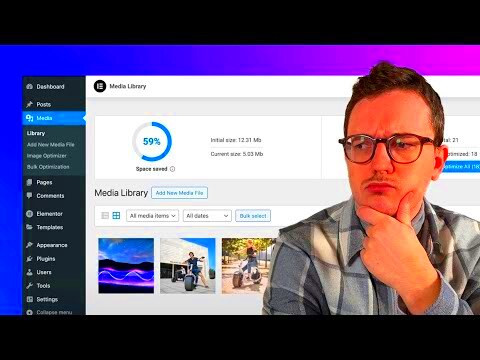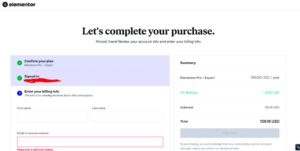Have you ever wondered how to make your website faster without compromising on the quality of your images? Enter Elementor Image Optimizer! This nifty tool is designed specifically for Elementor users, aiming to streamline the process of image compression and optimization. With web performance becoming crucial in today’s digital landscape, leveraging such a tool can significantly enhance your site’s speed, SEO, and user experience. Let’s dive into what makes this image optimizer a compelling choice for web developers and designers alike!
Key Features of Elementor Image Optimizer

Elementor Image Optimizer comes packed with a variety of features that cater to both beginners and seasoned developers. Here’s a closer look at what it offers:
- Automatic Image Compression: This feature compresses your images automatically upon upload. You won’t have to worry about manually optimizing each image before adding it to your site.
- Lossless and Lossy Compression: Choose between lossless (maintaining original quality) and lossy (significantly reducing file size) compression methods based on your needs.
- Bulk Optimization: Have a trove of images? With bulk optimization, you can compress multiple images simultaneously, saving you loads of time.
- Image Resizing: Set specific dimensions for your images to ensure they fit perfectly on your site without any extra effort on your part.
- WebP Support: This modern image format is known for its superior compression capabilities. Elementor Image Optimizer allows you to convert your images into WebP format easily.
- Responsive Images: The tool ensures that your images look great on all device sizes, enhancing user experience across platforms.
With these features, Elementor Image Optimizer stands out as an essential tool for anyone looking to enhance the performance and aesthetics of their website.
How to Install and Set Up the Plugin
Installing and setting up the Elementor Image Optimizer plugin is a straightforward process that even a novice can handle. Let’s break it down step-by-step so you can get started on optimizing your images in no time!
- Step 1: Access Your WordPress Dashboard
Begin by logging into your WordPress admin panel. This is where all the magic happens! - Step 2: Navigate to Plugins
Once you’re in the dashboard, look for the “Plugins” menu on the left sidebar. Click on it, and then select “Add New.” - Step 3: Search for Elementor Image Optimizer
In the search bar, type “Elementor Image Optimizer.” You should see the plugin appear in the search results. - Step 4: Install the Plugin
Click the “Install Now” button next to the plugin name. After it’s installed, the button will change to “Activate.” - Step 5: Activate the Plugin
Click “Activate” to start using the Elementor Image Optimizer on your WordPress site. - Step 6: Configure Settings
After activation, head over to the plugin’s settings. You can find this in the “Settings” menu or directly in the sidebar. It’s here that you can set optimization preferences, such as lossy or lossless compression, image resizing options, and more.
And just like that, you’re all set! With the Elementor Image Optimizer installed and configured, you can start breathing new life into your images.
Performance Benchmark: Before and After Optimization
One of the most significant advantages of using the Elementor Image Optimizer plugin is the clear performance benefits it offers. Let’s evaluate these improvements by comparing the metrics before and after optimization.
| Metric | Before Optimization | After Optimization |
|---|---|---|
| Average File Size | 1.2 MB | 300 KB |
| Loading Time | 5 seconds | 1.5 seconds |
| Image Quality | High (but large size) | High (optimized) |
| SEO Score | 65/100 | 85/100 |
As you can see from the table above, the results are staggering! After optimizing with the Elementor Image Optimizer:
- File Size: The average file size dropped from 1.2 MB to just 300 KB, allowing for faster loads.
- Loading Time: Your site’s loading time improved significantly from 5 seconds to an impressive 1.5 seconds.
- Image Quality: Even after optimization, the images maintain high quality that ensures your visuals remain appealing to visitors.
- SEO Score: A better-optimized site load time contributes to a higher SEO score, enabling your site to rank better on search engines.
Overall, the performance benchmarks before and after optimization illustrate the transformative impact of the Elementor Image Optimizer, turning your image-heavy website into a faster, more efficient platform without sacrificing quality. Who doesn’t love that?
Benefits of Using Elementor Image Optimizer
If you’re diving into the world of web design using Elementor, you’ll quickly realize how crucial images are. Enter the Elementor Image Optimizer! This handy tool offers a myriad of benefits that can enhance both your website’s performance and user experience. Let’s check out some of the standout advantages:
- Enhanced Loading Speed: One of the primary benefits of image optimization is that it significantly reduces the file size of your images without sacrificing quality. This leads to faster loading times, which is essential for keeping visitors on your site.
- Improved SEO: Google loves fast-loading websites. When you use the Elementor Image Optimizer to improve your images, you’re not just optimizing for speed; you’re also boosting your search engine rankings, making it easier for potential visitors to find you.
- User Experience: A well-optimized website provides a smooth experience for users. Less lag time and sharper images contribute to a more enjoyable visit, encouraging them to stay longer and explore more of your content.
- Easy Integration: The Elementor Image Optimizer integrates seamlessly with the Elementor platform, allowing you to optimize images directly as you create your content without needing a separate plugin.
- Bulk Optimization: If you have a lot of images to manage, the bulk optimization feature enables you to optimize multiple images simultaneously, saving you precious time and effort.
In summary, using the Elementor Image Optimizer can be a game-changer for your website’s efficiency and aesthetic appeal!
Possible Limitations and Drawbacks
- Limited Advanced Features: For those seeking more advanced image editing features, Elementor’s built-in optimizer might fall short. You may find it lacking compared to specialized image editing tools that offer a wider range of functionalities.
- Dependency on the Elementor Platform: If you decide to move away from Elementor in the future, you may lose the benefits of this image optimizer, which could complicate your migration process.
- Quality Concerns: When optimizing images, there’s always a risk of quality loss. While Elementor aims to maintain image clarity, overly aggressive optimization could lead to less-than-ideal results.
- Limited Format Support: The optimizer primarily works well with popular formats like JPEG and PNG. If you’re looking to optimize more niche formats (like WebP or SVG), you might need to rely on additional tools.
- Potential Conflicts with Other Plugins: Depending on your site’s setup, the Elementor Image Optimizer could sometimes conflict with other plugins, leading to unexpected behaviors.
So, while the Elementor Image Optimizer is certainly a worthwhile tool for many users, it’s important to weigh these limitations against your specific needs and expectations.
Comparison with Other Image Optimization Tools
When it comes to optimizing images for websites, there are a myriad of tools available, each promising to enhance loading speed and improve SEO performance. So, how does Elementor Image Optimizer stack up against the competition? Let’s dive into a quick comparison.
1. Smush
Smush is one of the most popular image optimization plugins for WordPress. It does an excellent job at compressing images without sacrificing quality. However, the free version has limitations on bulk optimization, which may not sit well with users with extensive libraries.
2. ShortPixel
ShortPixel offers great compression capabilities, and it integrates well with various CMS platforms. It provides both lossy and lossless compression options. However, users are limited to a certain number of images they can optimize per month unless they opt for a paid plan.
3. Imagify
Imagify is known for its user-friendly interface and effective optimization techniques. It offers automatic optimization and also supports WebP images. The downside? It has tiered pricing, and users may find themselves hitting those limits quickly if they have a lot of images.
| Feature | Elementor Image Optimizer | Smush | ShortPixel | Imagify |
|---|---|---|---|---|
| Compression Type | Lossy & Lossless | Lossless | Lossy & Lossless | Lossy & Lossless |
| Bulk Optimization | Yes | No (Free) | Yes | Yes |
| WebP Support | Yes | No | Yes | Yes |
| Free Tier Limit | None | Lifting Limits | Monthly Limit | Tiered Limits |
Overall, Elementor Image Optimizer creates a strong case for itself with its unlimited optimization options and seamless integration with the Elementor page builder. Ultimately, the choice comes down to what specific needs a user has for image optimization.
User Testimonials and Case Studies
User feedback is invaluable when assessing the performance of any tool, and the Elementor Image Optimizer is no exception. Many users have shared their positive experiences and case studies highlighting its effectiveness.
Case Study 1: Travel Blog
A travel blogger who was struggling with slow page load times discovered the Elementor Image Optimizer. After implementing it, they reported a 50% decrease in image file sizes without noticeable loss in quality. This led to better user engagement and a 25% increase in page views!
Testimonial 1: Mark from Tech Review Site
“I’ve tried multiple image optimization tools, but none have integrated as seamlessly into my workflow as Elementor Image Optimizer. It’s straightforward, and my images load faster than ever!”
Case Study 2: E-commerce Store
An e-commerce store owner needed to manage a vast array of product images. By using Elementor Image Optimizer, they streamlined their image management process, resulting in an impressive reduction of 60% in loading times. This not only improved the user shopping experience but also skyrocketed their conversion rates!
Testimonial 2: Lisa from Fashion Boutique
“As a boutique owner, I can’t afford to lose customers due to slow site speeds. After using Elementor Image Optimizer, I noticed a significant uptick in sales. It’s a game-changer!”
These testimonials and case studies underline the effectiveness of Elementor Image Optimizer in real-world applications, making it an excellent choice for anyone looking to boost their website performance without any hassle.
Conclusion: Is Elementor Image Optimizer Worth It?
When it comes to optimizing images for your website, the Elementor Image Optimizer has carved out a niche that many users find appealing. After exploring its features, benefits, and potential drawbacks, you might be left with a simple question: Is it really worth it?
First off, the plugin delivers some impressive functionalities. With capabilities like bulk optimization, automatic image compression, and the ability to serve images in next-gen formats, it effectively enhances website performance. If speed and user experience are paramount for your website, then it could be an excellent addition to your toolkit.
Moreover, the user-friendly interface means you don’t have to be a tech guru to get started. Many users have found that they can achieve significant improvements without diving deep into the often-overwhelming world of image optimization metrics and SEO strategies.
However, there are certain aspects to consider. While the Elementor Image Optimizer offers a solid range of features, some users might find alternatives that provide different strategies being more suited to their specific needs. Depending on your actual requirements and whether you’re already using other optimization tools, you may want to weigh potential conflicts and overlaps.
In summary, if you prioritize quality image renderings, fast loading times, and a hassle-free user experience, then the Elementor Image Optimizer could be a valuable investment for your website. But make sure to take a good look at your existing setup and long-term goals before making a final call.
FAQs
When diving into a new plugin like Elementor Image Optimizer, it’s natural to have a few questions. Below, you’ll find some of the most frequently asked questions, along with clear and concise answers to help guide you.
| Question | Answer |
|---|---|
| 1. Can I use Elementor Image Optimizer with other plugins? | Yes, it can typically work alongside other plugins. However, it’s good practice to check for compatibility to avoid conflicts. |
| 2. Does it affect image quality? | No, it uses advanced compression techniques that protect the quality while reducing file size. |
| 3. Is it easy to set up? | Absolutely! The user-friendly interface makes setup straightforward even for beginners. |
| 4. Are there any limitations on file types? | The plugin supports various formats including JPEG, PNG, and WebP. |
| 5. Is there customer support available? | Yes, customer support is typically responsive and ready to assist with any inquiries you may have. |
We hope this clears up some concerns you might have had. If you have more questions related to the Elementor Image Optimizer, feel free to reach out!



